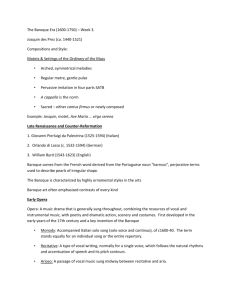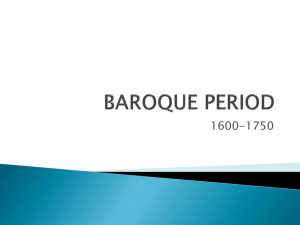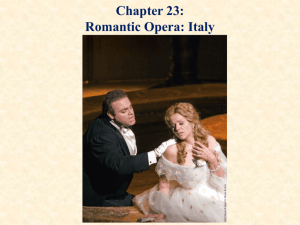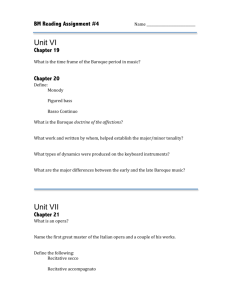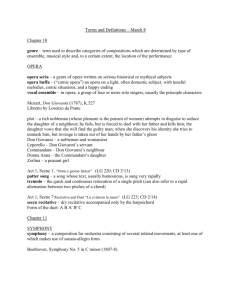11.0
advertisement
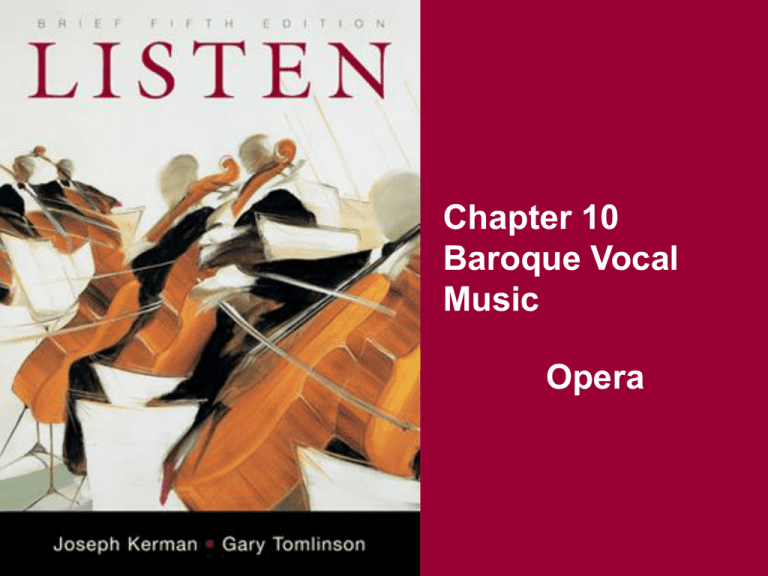
Chapter 10 Baroque Vocal Music Opera Key Terms “Affects” Coloratura Opera seria Libretto Librettist Recitative Secco recitative Accompanied recitative Castrato Aria Da capo (ABA) form Baroque Vocal Music Largest part of a Baroque composer’s output was vocal music • For solo voices, chorus, or both • In demand for church, court, & theater Close connection between words & music • “Affect” especially important in vocal music “Vocabulary of the emotions” • “Victory” expressed with trumpets, drums, lively march rhythms, & major key • “Sorrow” expressed with soft dynamics, slow rhythms, dissonances, & minor key Opera Reflected Baroque fascination with theater Flourished throughout Europe after 1600 The most spectacular, adventurous, glamorous, & influential Baroque genre • Combined music, vocal virtuosity, poetry, drama, dance, scenic splendor, & more • Elaborate stage machinery for rapid scene changes, deities in clouds or flying chariots, fire-breathing dragons, etc. • Intense expression of emotion foremost! Opera & Emotional Expression Opera allowed solo singers to express feelings in the most direct, powerful way Opera plots put characters in situations where intense emotion was natural Emotions intensified by music Also intensified by vocal virtuosity • Coloratura singing–fast brilliant runs, scales, high notes, vocal cadenzas, etc. • Great singers moved audiences by singing more beautifully, delicately, & emotionally Italian Opera Seria (1) Principal type of Italian Baroque opera was opera seria (serious opera) Plots often used tragic heroes, stories from ancient history & mythology Designed to stir powerful emotions • Passion, rage, grief, triumph, etc. • Many opportunities for singers to express these emotions one at a time • Needed more plot twists than a soap opera to make so many emotions believable Italian Opera Seria (2) Almost entirely solo singing • Featured sopranos & mezzo-sopranos (including castrati) • Tenors & basses played subordinate roles • Very few duets or choruses Libretto = the text of an opera • • • • Italian for “little book” Author of the text was the librettist Librettist shaped the drama Libretto alternated between prose texts (for recitative) & poetic texts (for arias) Recitative Musical declamation of words in a heightened, theatrical manner • Always with instrumental accompaniment Uses free rhythm of emotional speech Mirrors natural ups and downs of speech • As in angry outbursts, asides, questioning Words not repeated, as in speech Used in scenes that call for— • Action or dialogue • Special emphasis on the words Recitative Types Secco Recitative • Italian secco = dry • Simple continuo accompaniment only • Offers maximum flexibility for singer Accompanied Recitative • Accompanied by orchestra & continuo • Provides greater weight & emphasis • Reserved for the most excited, emotion-filled moments Aria A set piece for solo singer & orchestra Much more musical elaboration & coherence than recitative • Vocal part more melodic • Clear beat, rhythm, & meter • Orchestral accompaniment Singer-actor mulls over emotions at length • Plot action stops during aria • Frequent repetition of words & phrases Da Capo Form Standard Italian Baroque opera aria form Ternary form – A B A Based on poem in two stanzas • A section sets 1st stanza to music • Contrasting B section sets 2nd stanza Written instruction at end of B says— • Da capo (“from the head”) • Tells performers to go back to the beginning • Performers repeat entire A section Ornamentation & Da Capo Form Customary for solo singer to add ornamentation during repeat of A • Improvised runs, cadenzas, etc. • The slower the tempo, the more elaborate the ornaments • Permitted singer to show off vocal skill, virtuosity, & expressiveness • Greatly appreciated by Baroque audiences Recitative vs. Aria Free, speechlike rhythms Pitches follow speech patterns Continuo accompaniment Prose text (words stated once) Advances the action (movement) Dialogue–freely interactive Clear beat, consistent meter Pitches form melodic patterns & phrases Orchestral accompaniment Poetic text (phrases often repeated) Freezes the action (reflection) Soliloquy–expresses one emotion Castrato Castrati were biggest stars in Italian opera • Boys with beautiful voices who were castrated and never went through puberty • Their voices remained in soprano/alto range • Years of intensive vocal training made them virtuoso singers • Castrato voice highly prized—more powerful & brilliant than a woman’s voice Castrati sang most important male roles • Heroes, romantic leads, & supporting roles George Frideric Handel (1685-1759) Born in Halle, near Leipzig Played in Hamburg opera orchestra Successful journey to Italy • Wrote operas for Venice, Florence, & Rome Court musician to Elector of Hanover, who soon became England’s King George I Handel pursued a career in London • Opera impresario–composer, producer, etc. • Turned to oratorio as opera audiences dwindled Handel, Julius Caesar One of nearly 40 Italian operas for London Story from Roman history • Takes up events surrounding Egyptian Queen Cleopatra’s seduction of Roman emperor Julius Caesar • Cleopatra’s brother Ptolemy has murdered Pompey (Caesar’s foe) & put Cornelia (Pompey’s widow) in his own harem • Sextus (Cornelia’s son) seeks revenge on Ptolemy (& eventually kills him) Handel, “La giustizia” (1) Sextus promises revenge on Ptolemy Typical da capo aria–strict A B A form Aria begins with string orchestra ritornello • Sets the mood, or “affect,” right away • Sextus starts with the same music a bit later Handel, “La giustizia” (2) The “affect” expressed here is anger • Vigorous, strenuous music • Minor key • Loud explosions & coloratura on key words– “vendetta” (vengeance) “traditor” (traitor) “punire” (punish) • Dramatic pause near end of A Handel, “La giustizia” (3) B section provides subtle contrast • Visits new keys • More subdued mood • Orchestra drops out–only continuo used Return of A uses many ornaments • Flourishes added to high notes on “punire” & long note on “traditor” • Dramatic pause near end filled with virtuoso cadenza • Ornamented final cadence sweeps us away Aria “La giustizia” La giustizia ha già sull’ arco Pronto strale alla vendetta Per punire un traditor. Quanto è tarda la saetta Tanto più crudele aspetta La sua pena un empio cor. Justice now has in its bow The arrow primed for vengeance To castigate a traitor! The later the arrow is shot The crueler is the pain suffered By a dastardly heart!
